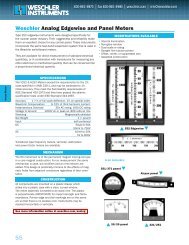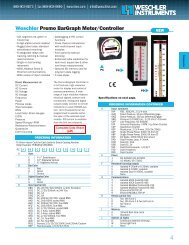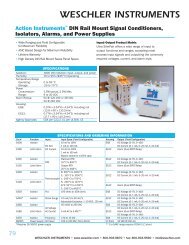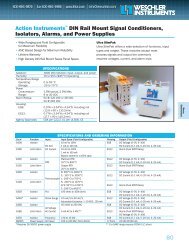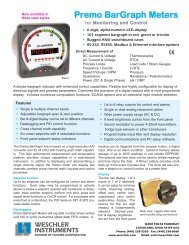WWW.MEGGER.COM
A practical guide to earth resistance testing - Weschler Instruments
A practical guide to earth resistance testing - Weschler Instruments
Create successful ePaper yourself
Turn your PDF publications into a flip-book with our unique Google optimized e-Paper software.
SECTION IIMeasuring Earth Resistancefor Electrical Grounding SystemsThe simplest and somewhat misleading idea of a good ground for anelectrical system is a section of iron pipe driven into the earth with a wireconductor connected from the pipe to the electrical circuit (Fig. 6). Thismay, or may not, be a suitable low resistance path for electric current toprotect personnel and equipment.Lightning RodEarthPlant ElectricWiringElectricMoto rElectricWireEarth Electr od e(Pipe driven into g r ound )Fig. 6: A simplified grounding system in an industrial plantA practical earth electrode that provides a low ground resistance is notalways easy to obtain. But from experience gained by others you can learnhow to set up a reliable system and how to check the resistance valuewith reasonable accuracy. As you will see, earth resistivity (refer to SectionI) has an important bearing on electrode resistance, as does the depth,size and shape of the electrode.The principles and methods of earth resistance testing covered in thissection apply to lightning arrester installations as well as to other systemsthat require low resistance ground connections. Such tests are made inpower-generating stations, electrical-distribution systems, industrial plants,and telecommunication systems.Factors That Can Change Your Minimum Earth ResistanceWe will discuss later what value of earth resistance is considered lowenough. You’ll see that there is no general rule usable for all cases. First,however, consider three factors that can change the earth electroderequirements from year to year:n A plant or other electrical facility can expand in size. Also, new plantscontinue to be built larger and larger. Such changes create differentneeds in the earth electrode. What was formerly a suitably low earthresistance can become an obsolete “standard.”n As facilities add more modern sensitive computer-controlled equipment,the problems of electrical noise is magnified. Noise that would noteffect cruder, older equipment can cause daily problems with newequipment.n As more nonmetallic pipes and conduits are installed underground,such installations become less and less dependable as effective, lowresistanceground connections.n In many locations, the water table is gradually falling. In a year or so,earth electrode systems that formerly were effective may end up in dryearth of high resistance.These factors emphasize the importance of a continuous, periodicprogram of earth-resistance testing. It is not enough to check the earthresistance only at the time of installation.Some Basic DefinitionsFirst, let’s define our terms. As early as 1918 4 , the terms ground,permanent ground, and ground connections were defined to mean“electrical connections intentionally made between electrical bodies (orconducting bodies in close proximity to electrical circuits) and metallicbodies in the earth — such as rods, water pipes, plates, or driven pipes.”4 Reference 19 (see page 77)16 1-866-254-0962 www.megger.com Getting Down to Earth 17



